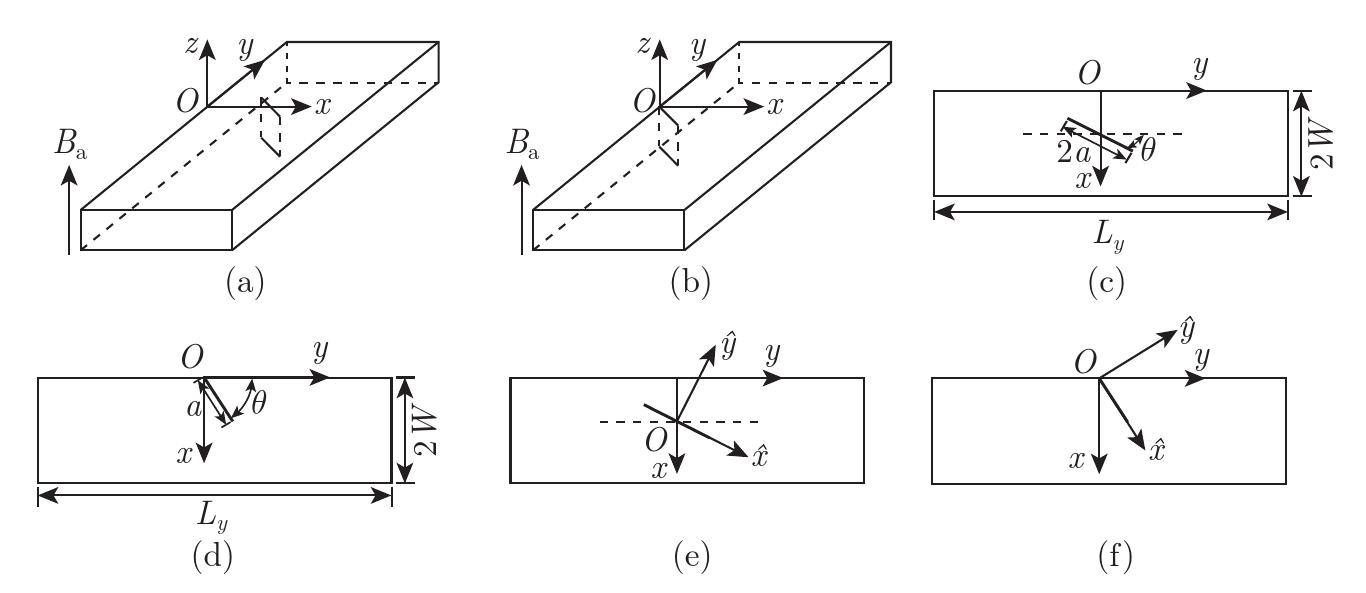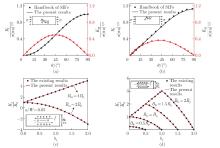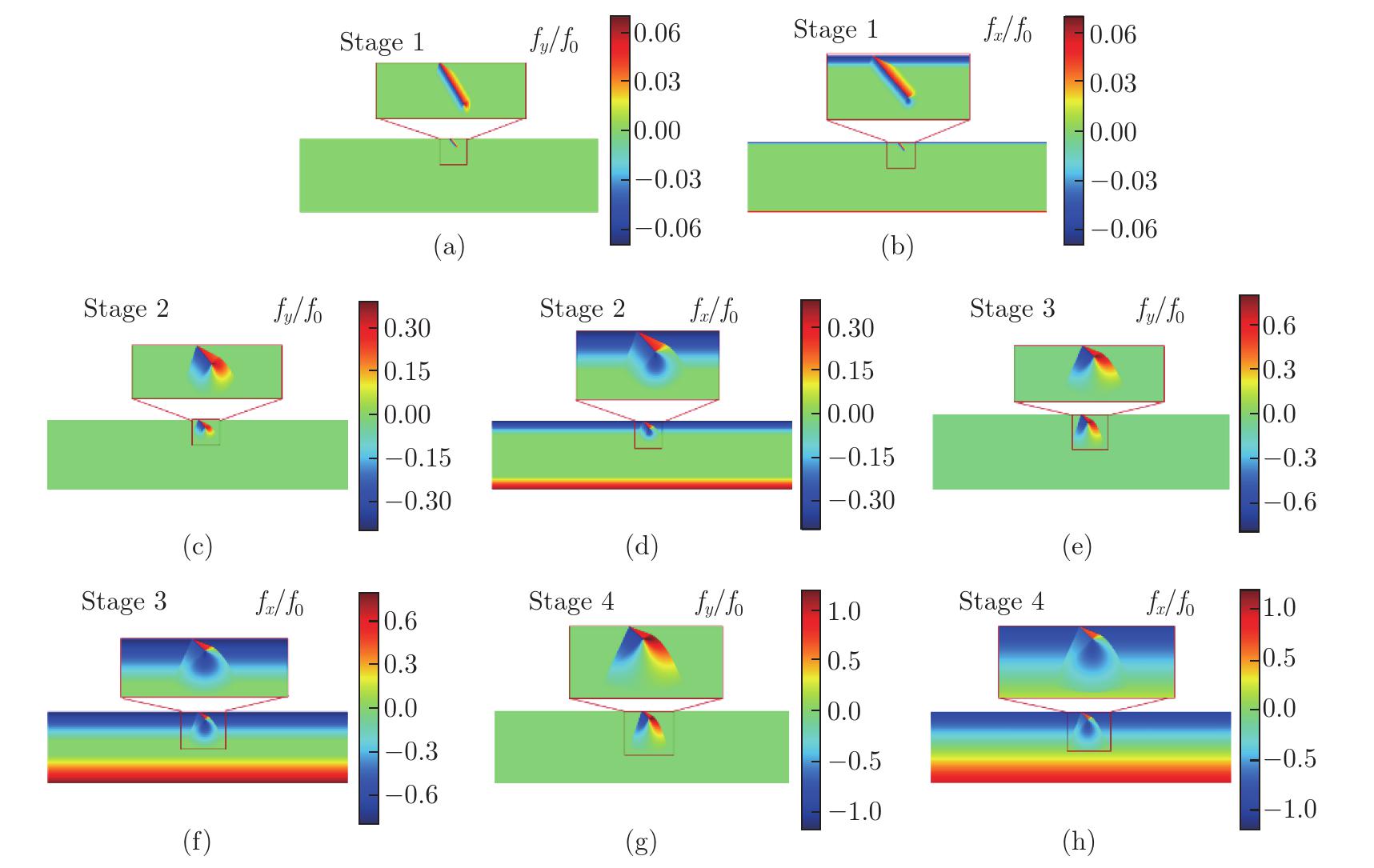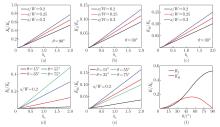Applied Mathematics and Mechanics (English Edition) ›› 2025, Vol. 46 ›› Issue (3): 485-500.doi: https://doi.org/10.1007/s10483-025-3227-6
Previous Articles Next Articles
Jinjian XIE1, Zhaoxia ZHANG2, Pengpeng SHI3, Xiaofan GOU1,†( )
)
Received:2024-09-20
Revised:2025-01-07
Published:2025-03-03
Contact:
Xiaofan GOU, E-mail: xfgou@hhu.edu.cnSupported by:2010 MSC Number:
Jinjian XIE, Zhaoxia ZHANG, Pengpeng SHI, Xiaofan GOU. Analytical solution for the fracture problem in superconducting tapes with oblique cracks under the electromagnetic force. Applied Mathematics and Mechanics (English Edition), 2025, 46(3): 485-500.

Fig. 1
Schematics of superconducting tapes in a perpendicular magnetic field with (a) a central oblique crack and (b) an edge oblique crack; two-dimensional schematics of superconducting tapes with (c) a central oblique crack and (d) an edge oblique crack; (e) local and global coordinate diagram for a central oblique crack; (f) local and global coordinate diagram for an edge oblique crack"


Fig. 6
Validation of KI and KII under tensile loading for (a) a central oblique crack and (b) an edge oblique crack. (c) Variation of KI during the process of transforming a central oblique crack into a central parallel crack when a/W=0.05 and the external magnetic field decreases from ba=2 to ba=0. (d) Variation of KI during the FC process for Bfc=0.5Bp, Bp, 1.5Bp, 2Bp (color online)"


Fig. 10
Distributions of electromagnetic force components fy and fx in the superconducting tape with an edge oblique crack: (a) fy and (b) fx in the first stage; (c) fy and (d) fx in the second stage; (e) fy and (f) fx in the third stage; (g) fy and (h) fx in the fourth stage (color online)"


Fig. 11
(a) Influence of the length of the vertical edge cracks on KI. Influence of the length of the oblique edge cracks on (b) KI and (c) KII. Influence of the oblique angle of the edge cracks on (d) KI and (e) KII. (f) Variation patterns of the maximum KI and KII values with respect to the crack angle (color online)"

| [1] | MAEDA, H. and YANAGISAWA, Y. Recent developments in high-temperature superconducting magnet technology. IEEE Transactions on Applied Superconductivity, 24(3), 4602412 (2014) |
| [2] | PAIDPILLI, M. and SELVAMANICKAM, V. Development of RE-Ba-Cu-O superconductors in the US for ultra-high field magnets. Superconductor Science and Technology, 35(4), 043001 (2022) |
| [3] | SAKAI, N., LEE, S., CHIKUMOTO, N., IZUMI, T., and TANABE, K. Delamination behavior of Gd123 coated conductor fabricated by PLD. Physica C: Superconductivity and its Applications, 471, 1075–1079 (2011) |
| [4] | VAN DER LAAN, D. C., EKIN, J., CLICKNER, C. C., and STAUFFER, T. C. Delamination strength of YBCO coated conductors under transverse tensile stress. Superconductor Science and Technology, 20, 765–770 (2007) |
| [5] | YANAGISAWA, Y., NAKAGOME, H., TAKEMATSU, T., TAKAO, T., SATO, N., TAKAHASHI, M., and MAEDA, H. Remarkable weakness against cleavage stress for YBCO-coated conductors and its effect on the YBCO coil performance. Physica C: Superconductivity and its Applications, 471, 480–485 (2011) |
| [6] | DIKO, P. Cracking in melt-grown RE-Ba-Cu-O single-grain bulk superconductors. Superconductor Science and Technology, 17(11), R45 (2004) |
| [7] | TOMITA, M. and MURAKAMI, M. High-temperature superconductor bulk magnets that can trap magnetic fields of over 17 tesla at 29 K. nature, 421, 517–520 (2003) |
| [8] | HAHN, S., KIM, K., KIM, K., HU, X., PAINTER, T., DIXON, I., KIM, S., BHATTARAI, K. R., NOGUCHI, S., JAROSZYNSKI, J., and LARBALESTIER, D. C. 45.5-tesla direct-current magnetic field generated with a high-temperature superconducting magnet. nature, 570, 496–499 (2019) |
| [9] | HARTNETT, W. N., RAMIREZ, J., OLSON, T. E., HOPP, C. T., JEWELL, M. C., KNOLL, A. R., HAZELTON, D. W., and ZHANG, Y. F. Characterization of edge damage induced on REBCO superconducting tape by mechanical slitting. Engineering Research Express, 3(3), 035007 (2021) |
| [10] | MIYAMOTO, T., NAGASHIMA, K., SAKAI, N., and MURAKAMI, M. Direct measurements of mechanical properties for large-grain bulk superconductors. Physica C: Superconductivity and its Applications, 340, 41–50 (2000) |
| [11] | ZHOU, Y. H., LIU, C., SHEN, L., and ZHANG, X. Y. Probing of the internal damage morphology in multilayered high-temperature superconducting wires. Nature Communications, 12, 3110 (2021) |
| [12] | YONG, H. D., JING, Z., and ZHOU, Y. H. Crack problem for superconducting strip with finite thickness. International Journal of Solids and Structures, 51(3-4), 886–893 (2014) |
| [13] | HE, A., XUE, C., YONG, H. D., and ZHOU, Y. H. Fracture behaviors of thin superconducting films with field-dependent critical current density. Physica C: Superconductivity and its Applications, 492, 25–31 (2013) |
| [14] | YANG, Z. R., LI, Y., SONG, P., GUAN, M. Z., FENG, F., and QU, T. M. Effect of edge cracks on critical current degradation in REBCO tapes under tensile stress. Superconductivity, 1, 100007 (2022) |
| [15] | JIANG, Z. F., HUANG, Y. Q., JIANG, D. H., CHEN, W. G., and KUANG, G. L. Influence of edge crack propagation on critical current degradation of REBCO tape studied by phase-field fracture method and current shunting model. IEEE Transactions on Applied Superconductivity, 33(2), 1–11 (2023) |
| [16] | JIANG, Z. F., ZHOU, X. X., and JIANG, D. H. The Fracture behavior of REBCO tape with multiple oblique edge cracks. Journal of Superconductivity and Novel Magnetism, 36, 477–485 (2023) |
| [17] | MA, J. T. and GAO, Y. W. Numerical analysis of the mechanical and electrical properties of (RE)BCO tapes with multiple edge cracks. Superconductor Science and Technology, 36(9), 095013 (2023) |
| [18] | ZENG, J., YONG, H. D., and ZHOU, Y. H. Edge-crack problem in a long cylindrical superconductor. Journal of Applied Physics, 109, 093920 (2011) |
| [19] | ZENG, J., ZHOU, Y. H., and YONG, H. D. Fracture behaviors induced by electromagnetic force in a long cylindrical superconductor. Journal of Applied Physics, 108, 033901 (2010) |
| [20] | FENG, W. J., GAO, S. W., and LI, Y. S. An inner annular crack in a superconducting cylinder and its crack front properties under applied magnetic field. Applied Mathematical Modelling, 40, 2529–2540 (2016) |
| [21] | FENG, W. J., GAO, S. W., and LIU, L. L. Fracture properties of a cylindrical superconductor with a central cross crack. Journal of Applied Physics, 113, 203919 (2013) |
| [22] | GAO, S. W., FENG, W. J., FANG, X. Q., and ZHANG, G. L. Fracture analysis for a penny-shaped crack problem of a superconducting cylinder in a parallel magnetic field. Physica C: Superconductivity and its Applications, 506, 6–11 (2014) |
| [23] | GAO, S. W., FENG, W. J., and LIU, J. X. Fracture problems of a superconducting slab with a central kinked crack. Journal of Applied Physics, 114, 243907 (2013) |
| [24] | AN, D. M., SHI, P. P., and GOU, X. F. Fracture behavior of superconductor REBCO tapes with multiple edge cracks under electromagnetic force. Engineering Fracture Mechanics, 295, 109794 (2024) |
| [25] | HILLS, D. A. Solution of Crack Problems: the Distributed Dislocation Technique, Kluwer Academic Publishers, Dordrecht, 29–64 (1996) |
| [26] | JIN, X. Q. and KEER, L. M. Solution of multiple edge cracks in an elastic half plane. International Journal of Fracture, 137, 121–137 (2006) |
| [27] | LI, X. T., LI, X., and JIANG, X. Y. Influence of a micro-crack on the finite macro-crack. Engineering Fracture Mechanics, 177, 95–103 (2017) |
| [28] | LI, X. T., LI, X., YANG, H. D., and JIANG, X. Y. Analysis of the effect of a micro-crack on plastic zone of the edge macro-crack tip by macroscopic and microscopic methods. Engineering Fracture Mechanics, 201, 1–12 (2018) |
| [29] | ZHANG, J., QU, Z., HUANG, Q. Q., XIE, L. C., and XIONG, C. B. Solution of multiple cracks in a finite plate of an elastic isotropic material with the distributed dislocation method. Acta Mechanica Solida Sinica, 27, 276–283 (2014) |
| [30] | YONG, H. D., XUE, C., and ZHOU, Y. H. Thickness dependence of fracture behaviour in a superconducting strip. Superconductor Science and Technology, 26(5), 055003 (2013) |
| [31] | GAO, Z. W., ZHENG, Z. Y., and LI, X. Y. Fracture problem of a nonhomogeneous high temperature superconductor slab based on real fundamental solutions. Physica C: Superconductivity and its Applications, 519, 5–12 (2015) |
| [32] | LIU, Q. F., YAN, Z., and FENG, W. J. Fracture behaviors for a functionally graded superconducting cylinder with a cylindrical crack. Mechanics of Advanced Materials and Structures, 24, 176–182 (2017) |
| [33] | XUE, F. and GOU, X. F. Crack problem for a bulk superconductor with nonsuperconducting inclusions under an electromagnetic force. AIP Advances, 5, 047128 (2015) |
| [34] | XUE, F., ZHANG, Z. X., and GOU, X. F. Fracture behavior of an inclined crack interacting with a circular inclusion in a high-TC superconductor under an electromagnetic force. AIP Advances, 5, 117141 (2015) |
| [35] | ZHANG, Z. X. and GOU, X. F. Interaction among multiple parallel cracks in REBCO superconductor bulks under applied magnetic fields: a boundary element analysis. IEEE Transactions on Applied Superconductivity, 34(6), 1–10 (2024) |
| [36] | FENG, W. J., LIU, Q. F., and HAN, X. Crack problem for a functionally graded thin superconducting film with field dependent critical currents. Mechanics Research Communications, 61, 36–40 (2014) |
| [37] | FENG, W. J., ZHANG, R., and DING, H. M. Crack problem for an inhomogeneous orthotropic superconducting slab under an electromagnetic force. Physica C: Superconductivity and its Applications, 477, 32–35 (2012) |
| [38] | ZHOU, Y. H. and YONG, H. D. Crack problem for a long rectangular slab of superconductor under an electromagnetic force. Physical Review B, 76, 094523 (2007) |
| [39] | KELLY, P. and O'CONNOR, J. Transmission of rapidly applied loads through articular cartilage, part 2: cracked cartilage. Proceedings of the Institution of Mechanical Engineers, Part H: Journal of Engineering in Medicine, 210(1), 39–49 (1996) |
| [40] | KELLY, P., O'CONNOR, J., and HILLS, D. The stress field due to a dislocation in layered media. Journal of Physics D: Applied Physics, 28(3), 530 (1995) |
| [41] | ERDOGAN, F., GUPTA, G. D., and COOK, T. S. Numerical Solution of Singular Integral Equations, Springer, Dordrecht, 368 (1973) |
| [42] | KAYA, A. C. and ERDOGAN, F. On the solution of integral equations with strongly singular kernels. Quarterly of Applied Mathematics, 45(1), 105–122 (1987) |
| [43] | KRENK, S. On the use of the interpolation polynomial for solutions of singular integral equations. Quarterly of Applied Mathematics, 32, 479–484 (1975) |
| [44] | YONG, H. D., YANG, Y., and ZHOU, Y. H. Dynamic fracture behavior of a crack in the bulk superconductor under electromagnetic force. Engineering Fracture Mechanics, 158, 167–178 (2016) |
| [45] | Chinese Aeronautical Establishment. Handbook of Stress Intensity Factors(in Chinese), Science Press, Beijing, 212 (1993) |
| [1] | Zhangna XUE, Huameng WANG, Jianlin LIU, Minjie WEN, Z. T. CHEN. Thermal fracture analysis of two collinear cracks in a functionally graded medium based on the three-phase-lag model [J]. Applied Mathematics and Mechanics (English Edition), 2025, 46(3): 501-520. |
| [2] | Zhenliang HU, Xueyang ZHANG, Xianfang LI. Bending strength degradation of a cantilever plate with surface energy due to partial debonding at the clamped boundary [J]. Applied Mathematics and Mechanics (English Edition), 2024, 45(9): 1573-1594. |
| [3] | Shijing GAO, Lele ZHANG, Jinxi LIU, Guoquan NIE, Weiqiu CHEN. Indentation behavior of a semi-infinite piezoelectric semiconductor under a rigid flat-ended cylindrical indenter [J]. Applied Mathematics and Mechanics (English Edition), 2024, 45(4): 649-662. |
| [4] | Xu WANG, Hailiang MA, Yonglin YANG, Xing LI, Yueting ZHOU. Partial wetting of the soft elastic graded substrate due to elastocapillary deformation [J]. Applied Mathematics and Mechanics (English Edition), 2023, 44(8): 1409-1422. |
| [5] | Huayang DANG, Dongpei QI, Minghao ZHAO, Cuiying FAN, C.S. LU. Thermal-induced interfacial behavior of a thin one-dimensional hexagonal quasicrystal film [J]. Applied Mathematics and Mechanics (English Edition), 2023, 44(5): 841-856. |
| [6] | Yansong WANG, Baolin WANG, Youjiang CUI, Kaifa WANG. Anti-plane pull-out of a rigid line inclusion from an elastic medium [J]. Applied Mathematics and Mechanics (English Edition), 2023, 44(5): 809-822. |
| [7] | Jian CHEN, Yawei WANG, Xianfang LI. Antiplane shear crack in a prestressed elastic medium based on the couple stress theory [J]. Applied Mathematics and Mechanics (English Edition), 2023, 44(4): 583-602. |
| [8] | Juan PENG, Dengke LI, Zaixing HUANG, Guangjian PENG, Peijian CHEN, Shaohua CHEN. Interfacial behavior of a thermoelectric film bonded to a graded substrate [J]. Applied Mathematics and Mechanics (English Edition), 2023, 44(11): 1853-1870. |
| [9] | Xin ZHANG, Minghao ZHAO, Cuiying FAN, C. S. LU, Huayang DANG. Three-dimensional interfacial fracture analysis of a one-dimensional hexagonal quasicrystal coating [J]. Applied Mathematics and Mechanics (English Edition), 2022, 43(12): 1901-1920. |
| [10] | Minghao ZHAO, Cuiying FAN, C. S. LU, Huayang DANG. Interfacial fracture analysis for a two-dimensional decagonal quasi-crystal coating layer structure [J]. Applied Mathematics and Mechanics (English Edition), 2021, 42(11): 1633-1648. |
| [11] | Peng JIANG, Hai QING, Cunfa GAO. Theoretical analysis on elastic buckling of nanobeams based on stress-driven nonlocal integral model [J]. Applied Mathematics and Mechanics (English Edition), 2020, 41(2): 207-232. |
| [12] | Yihui DA, Bin WANG, D. Z. LIU, Zhenghua QIAN. An analytical approach to reconstruction of axisymmetric defects in pipelines using T(0, 1) guided waves [J]. Applied Mathematics and Mechanics (English Edition), 2020, 41(10): 1479-1492. |
| [13] | Deshun LI, Tao GUO, Rennian LI, Congxin YANG, Zhaoxue CHENG, Ye LI, Wenrui HU. A nonlinear model for aerodynamic configuration of wake behind horizontal-axis wind turbine [J]. Applied Mathematics and Mechanics (English Edition), 2019, 40(9): 1313-1326. |
| [14] | M. HAJIMOHAMADI, R. GHAJAR. An analytical solution for the stress field and stress intensity factor in an infinite plane containing an elliptical hole with two unequal aligned cracks [J]. Applied Mathematics and Mechanics (English Edition), 2018, 39(8): 1103-1118. |
| [15] | H. S. ZHAO, Y. ZHANG, S. T. LIE. Frequency equations of nonlocal elastic micro/nanobeams with the consideration of the surface effects [J]. Applied Mathematics and Mechanics (English Edition), 2018, 39(8): 1089-1102. |
| Viewed | ||||||
|
Full text |
|
|||||
|
Abstract |
|
|||||


 Email Alert
Email Alert RSS
RSS